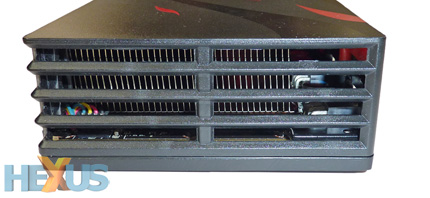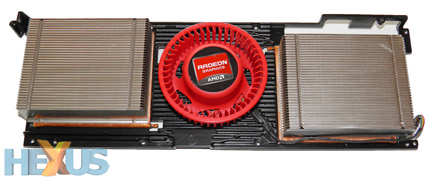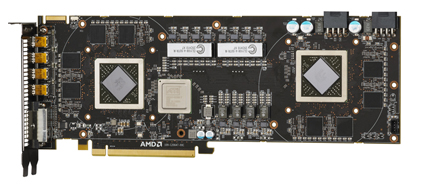A look at the beast
Looks rather unassuming for the fastest consumer graphics card every made, doesn't it? All the magic, naturally, is contained inside the big-ass heatsink that stretches the entire 12 inches across the PCB. Take a gander through the front vent and some of that meaty heatsink goodness comes into view.No child-like 6-pin connectors here, folks. It's all systems (and then some) go with two 8-pin PCIe plugs that are nicely spaced apart. Important from a design and chassis-housing perspective, both are located to the side.
Carry on down and the Switch of Awesomeness sits next to a single CrossFireX connector. As shown, and as shipped by AMD, it's in the default 830MHz/5,000MHz setting. Flick it over and you have the 880MHz/5,000MHz frequencies of a turbo 'OC' card.
And the five outputs plumbed out of the rear. AMD is set to provide three adapters in each retail box, irrespective of which partner markets the card. These include a miniDP to single-link DVI (passive), miniDP to single-link DVI (active), and miniDP to HDMI (passive).
The big beastie in its twin-GPU glory. Weighing in at 1,155g and sure to take the currently-contested title of fastest graphics card in the world, at least until the GeForce GTX 590 has been benchmarked, let's get a little more personal.
The two-piece cooler encapsulates the PCB. Eight 2Gbit Hynix GDDR5 memory devices are apportioned to each GPU - four on the front and rear - while the larger pad, near the right-hand GPU, covers the AMD PCIe switch - the same version found on the also-twin-GPU Radeon HD 5970.
The two GPUs sit slightly offset one another, most likely due to AMD needing room to house two 8-pin power connectors.
And there you have it; two Radeon HD 6900-series GPUs working in tandem, connected by a switch to the system, and regulated by some chunky Volterra chips. Yum, yum, yum.
Now, without further ado, let's bench this behemoth!


















